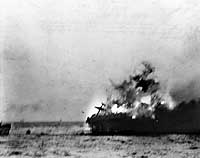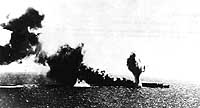Battle of the Coral Sea: Difference between revisions
imported>Howard C. Berkowitz No edit summary |
imported>Howard C. Berkowitz No edit summary |
||
| Line 1: | Line 1: | ||
{{subpages}} | {{subpages}} | ||
The first battle between forces led by [[aircraft carrier]]s, in which the ships never saw one another, the '''Battle of the Coral Sea''' took place on 7-8 May 1942, in the waters southwest of the [[Solomon Islands]] and eastward from [[New Guinea]]. While the [[U.S. Navy]] lost more tonnage than the [[Imperial Japanese Navy]], the battle is considered a strategic victory for the U.S., because it caused, for the first time, a Japanese invasion fleet to turn back. | The first battle between forces led by [[aircraft carrier]]s, in which the ships never saw one another, the '''Battle of the Coral Sea''' took place on 7-8 May 1942, in the waters southwest of the [[Solomon Islands]] and eastward from [[New Guinea]]. While the [[U.S. Navy]] lost more tonnage than the [[Imperial Japanese Navy]], the battle is considered a strategic victory for the U.S., because it caused, for the first time, a Japanese invasion fleet to turn back. | ||
Operation MO, under the command of VADM [[Shigeyoshi Inoue]], planned [[amphibious warfare|amphibious landings]] on [[Tulagi]] and [[Port Moresby]].<ref name=CSA-Battle>{{citation | |||
| title = The Battle of the Coral Sea | |||
| publisher = '''USS Coral Sea (CVA-43)''' Association | |||
| url = http://www.usscoralsea.org/pages/botcs.php}}</ref> A second strategic effect was reducing the Japanese resources available for the [[Battle of Midway]], approximately a month later. <ref name=NHC>{{citation | |||
| url = http://www.history.navy.mil/photos/events/wwii-pac/coralsea/coralsea.htm | | url = http://www.history.navy.mil/photos/events/wwii-pac/coralsea/coralsea.htm | ||
| publisher = Naval Historical Center, [[United States Navy]] | | publisher = Naval Historical Center, [[United States Navy]] | ||
| title = Battle of the Coral Sea, 7-8 May 1942 -- Overview and Special Image Selection}}</ref> | | title = Battle of the Coral Sea, 7-8 May 1942 -- Overview and Special Image Selection}}</ref> | ||
==Opposing forces== | |||
[[Image:Lexington sinks at Coral Sea.jpg|thumb|250px|''USS Lexington (CV-2)'']] | [[Image:Lexington sinks at Coral Sea.jpg|thumb|250px|''USS Lexington (CV-2)'']] | ||
The U.S. unit, Task Force 17 (RADM [[Frank Fletcher]], [[United States Navy]]), built around [[USS Lexington (CV-2)]] and [[USS Yorktown (CV-5)]] | The U.S. unit, Task Force 17 (RADM [[Frank Fletcher]], [[United States Navy]]), built around [[USS Lexington (CV-2)]] and [[USS Yorktown (CV-5)]]. In support, but not taking part in the main battle, was Task Force 44 (RADM [[John Crace]], [[Royal Australian Navy]]).<ref name=Jane>{{citation | ||
| title = Oceania: The Battle of the Coral Sea | | title = Oceania: The Battle of the Coral Sea | ||
| publisher = Jane's Oceania | | publisher = Jane's Oceania | ||
| url = http://www.janesoceania.com/oceania_coral_sea/index.htm}}</ref> | | url = http://www.janesoceania.com/oceania_coral_sea/index.htm}}</ref> | ||
Close-in Japanese airpower would be provided by land-based airpower from bases to the north and by two naval forces containing a small aircraft carrier, ''[[IJN Shoho]]'', several cruisers, seaplane tenders and gunboats. More distant cover would be provided by the fleet containing the aircraft carriers ''[[IJN Shokaku]]'' and ''[[IJN Zuikaku]]'' and escorts. VADM [[Takeo Tagaki]] was in overall command. | Close-in Japanese airpower would be provided by land-based airpower from bases to the north and by two naval forces containing a small aircraft carrier, ''[[IJN Shoho]]'', several cruisers, seaplane tenders and gunboats. More distant cover would be provided by the fleet containing the aircraft carriers ''[[IJN Shokaku]]'' and ''[[IJN Zuikaku]]'' and escorts. VADM [[Takeo Tagaki]] was in overall command; RADM [[Tadaichi Hara]] commanded the large carriers.<ref name=CSA-Battle /> | ||
==Outcome== | |||
The two sides lost approximately the same number of aircraft (75 American, 74 Japanese), with a good many lost when carriers sunk. While it was only the beginning, however, pilot losses were more significant. Japan had started the war with excellent naval aviators, but they had no effective system for replacing pilots, while the U.S. had a rotation system that produced new pilots almost as quickly as airplanes. | |||
[[Image:Shoho sinks at Coral Sea.jpg|left|thumb|250px|Light carrier ''IJN Shoho'']] | [[Image:Shoho sinks at Coral Sea.jpg|left|thumb|250px|Light carrier ''IJN Shoho'']] | ||
''Shokaku'' was seriously damaged, and, while ''Zuikaku'' was not heavily hit, she had to spend six weeks obtaining new aircraft and pilots. Neither were able to participate in the [[Battle of Midway]]. Midway, usually considered the turning point of the Pacific War, was a very close battle; had the six carriers of the Mobile Striking Fleet that were at the [[Battle of Pearl Harbor]] were present, rather than the four that were used, the outcome could have been very different. <ref name=Combined-Coral>{{citation | ''Shokaku'' was seriously damaged, and, while ''Zuikaku'' was not heavily hit, she had to spend six weeks obtaining new aircraft and pilots. Neither were able to participate in the [[Battle of Midway]]. Midway, usually considered the turning point of the Pacific War, was a very close battle; had the six carriers of the Mobile Striking Fleet that were at the [[Battle of Pearl Harbor]] were present, rather than the four that were used, the outcome could have been very different. <ref name=Combined-Coral>{{citation | ||
| Line 19: | Line 25: | ||
| publisher = Imperial Japanese Navy Site | | publisher = Imperial Japanese Navy Site | ||
| url = http://www.combinedfleet.com/battles/Battle_of_Coral_Sea}}</ref> | | url = http://www.combinedfleet.com/battles/Battle_of_Coral_Sea}}</ref> | ||
The U.S. lost the ''Lexington'', the destroyer ''USS Sims'', and the fleet oiler ''USS Neosho''. ''Yorktown'' was damaged and expected to be out of service for three months, but unprecedented repair activity at Pearl Harbor sent her back out to sea in three days, some shipyard workers still aboard, to the Battle of Midway. She sank during that battle, but not before playing an important part in the victory. | |||
==References== | ==References== | ||
{{reflist|2}} | {{reflist|2}} | ||
Revision as of 13:21, 18 February 2009
The first battle between forces led by aircraft carriers, in which the ships never saw one another, the Battle of the Coral Sea took place on 7-8 May 1942, in the waters southwest of the Solomon Islands and eastward from New Guinea. While the U.S. Navy lost more tonnage than the Imperial Japanese Navy, the battle is considered a strategic victory for the U.S., because it caused, for the first time, a Japanese invasion fleet to turn back.
Operation MO, under the command of VADM Shigeyoshi Inoue, planned amphibious landings on Tulagi and Port Moresby.[1] A second strategic effect was reducing the Japanese resources available for the Battle of Midway, approximately a month later. [2]
Opposing forces
The U.S. unit, Task Force 17 (RADM Frank Fletcher, United States Navy), built around USS Lexington (CV-2) and USS Yorktown (CV-5). In support, but not taking part in the main battle, was Task Force 44 (RADM John Crace, Royal Australian Navy).[3]
Close-in Japanese airpower would be provided by land-based airpower from bases to the north and by two naval forces containing a small aircraft carrier, IJN Shoho, several cruisers, seaplane tenders and gunboats. More distant cover would be provided by the fleet containing the aircraft carriers IJN Shokaku and IJN Zuikaku and escorts. VADM Takeo Tagaki was in overall command; RADM Tadaichi Hara commanded the large carriers.[1]
Outcome
The two sides lost approximately the same number of aircraft (75 American, 74 Japanese), with a good many lost when carriers sunk. While it was only the beginning, however, pilot losses were more significant. Japan had started the war with excellent naval aviators, but they had no effective system for replacing pilots, while the U.S. had a rotation system that produced new pilots almost as quickly as airplanes.
Shokaku was seriously damaged, and, while Zuikaku was not heavily hit, she had to spend six weeks obtaining new aircraft and pilots. Neither were able to participate in the Battle of Midway. Midway, usually considered the turning point of the Pacific War, was a very close battle; had the six carriers of the Mobile Striking Fleet that were at the Battle of Pearl Harbor were present, rather than the four that were used, the outcome could have been very different. [4]
The U.S. lost the Lexington, the destroyer USS Sims, and the fleet oiler USS Neosho. Yorktown was damaged and expected to be out of service for three months, but unprecedented repair activity at Pearl Harbor sent her back out to sea in three days, some shipyard workers still aboard, to the Battle of Midway. She sank during that battle, but not before playing an important part in the victory.
References
- ↑ 1.0 1.1 The Battle of the Coral Sea, USS Coral Sea (CVA-43) Association
- ↑ Battle of the Coral Sea, 7-8 May 1942 -- Overview and Special Image Selection, Naval Historical Center, United States Navy
- ↑ Oceania: The Battle of the Coral Sea, Jane's Oceania
- ↑ Battle of the Coral Sea (May 7-8, 1942), Imperial Japanese Navy Site

